Broadcom BRCM1005-E 54g WLAN Mini PCI Card User Manual W730 USER GUIDE ENGLISH
Broadcom Corporation 54g WLAN Mini PCI Card W730 USER GUIDE ENGLISH
Broadcom >
User Guide

Notebook PC
User's Guide
Model: W730-P4/ W730-K8/ W730-K7
First Edition: January 2004

User's Guide
Page II
Specifications and information found in this guide are subject to change
without notice. Any changes therefore will be incorporated in future
editions. The manufacturer assumes no responsibility for errors or
omissions in this document.
Windows® XP is the trademark of Microsoft Corporation.
Intel® is the trademark of Intel Corporation.
AMD® is the trademark of AMD Corporation.
Other trademarks are properties of their respective owners.
NOTICE
TRADEMARKS
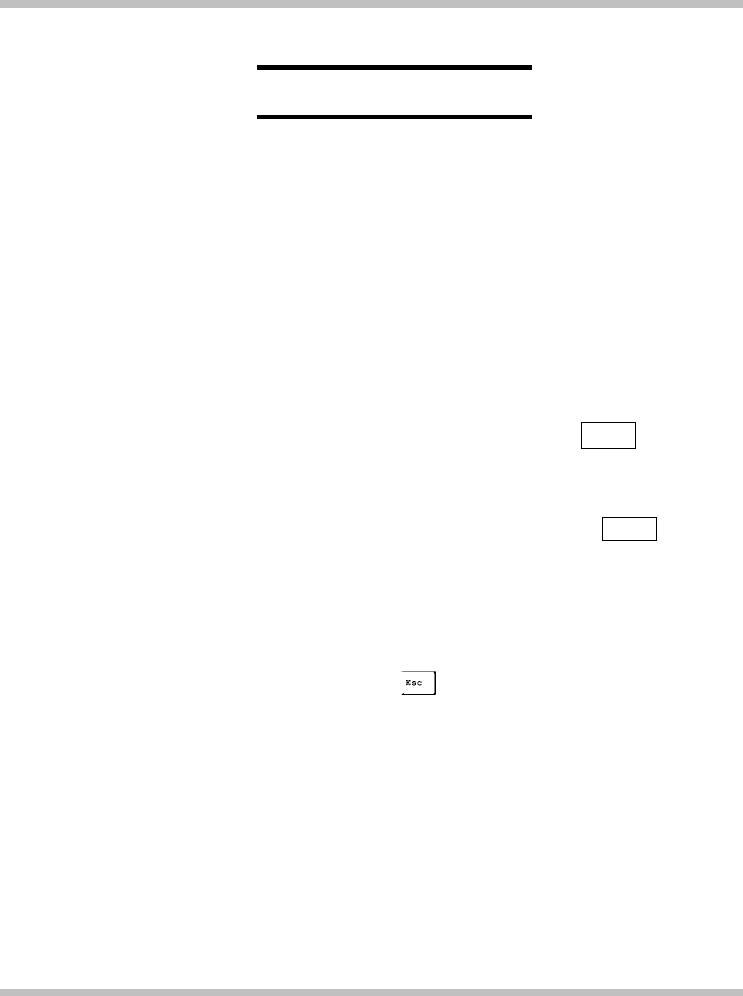
User's Guide
Page III
The following standards are adopted throughout this guide:
Notebook in boldface (with or without capitalization) refers to the notebook
computer that you have purchased.
Boldface type is also used to highlight important information in this
document.
The messages that appear on the Notebook screen will be boxed when they
are referenced.
Whenever extra caution is called for, the information will be boxed in a dark
frame preceded by "Note:" or "Warning:"
Usually after performing a step-by-step instruction, you will be asked to:
Press the Esc key
Which means you should press the key located at the upper left-hand
corner of the keyboard.
Standards

User’s Guide Contents
Page V
CHAPTER 1 BEFORE YOU BEGIN .................................................. 1-1
1.1 CHECKING WHAT YOU RECEIVED .......................................................................1-1
1.2 EXAMINING YOUR COMPUTER .............................................................................1-2
1.3 THE FIVE STATUS LEDS.......................................................................................1-6
1.4 THE TWO POWER LEDS........................................................................................1-7
1.5 THE SEVEN SYSTEM BUTTONS ............................................................................1-8
1.6 ATTENTION ON HANDLES AND SOCKET DOORS ................................................1-9
1.7 THE <FN> KEY ....................................................................................................1-10
CHAPTER 2 BATTERY ........................................................................ 2-1
2.1 BATTERY PACK......................................................................................................2-1
2.2 RECHARGING THE BATTERY PACK ......................................................................2-1
2.3 QUESTIONS AND ANSWERS...................................................................................2-2
2.4 BATTERY MAINTENANCE .....................................................................................2-3
2.5 POWER CONSUMPTION..........................................................................................2-3
2.6 REDUCING POWER CONSUMPTION.......................................................................2-4
2.7 REMOVING THE BATTERY PACK..........................................................................2-5
CHAPTER 3 MEMORY ........................................................................ 3-1
3.1 REMOVING MEMORY MODULE ............................................................................3-2
CHAPTER 4 MINI-PCI MODULE...................................................... 4-1
4.1 REMOVING MINI-PCI MODULE ...........................................................................4-1
CHAPTER 5 THE HDD DRIVE........................................................... 5-1
5.1 REMOVING THE HARD DISK DRIVE.....................................................................5-1
APPENDIX A- AGENCY REGULATORY NOTICES ................... A-1
APPENDIX B- ENVIRONMENT........................................................ B-1
CONTENTS
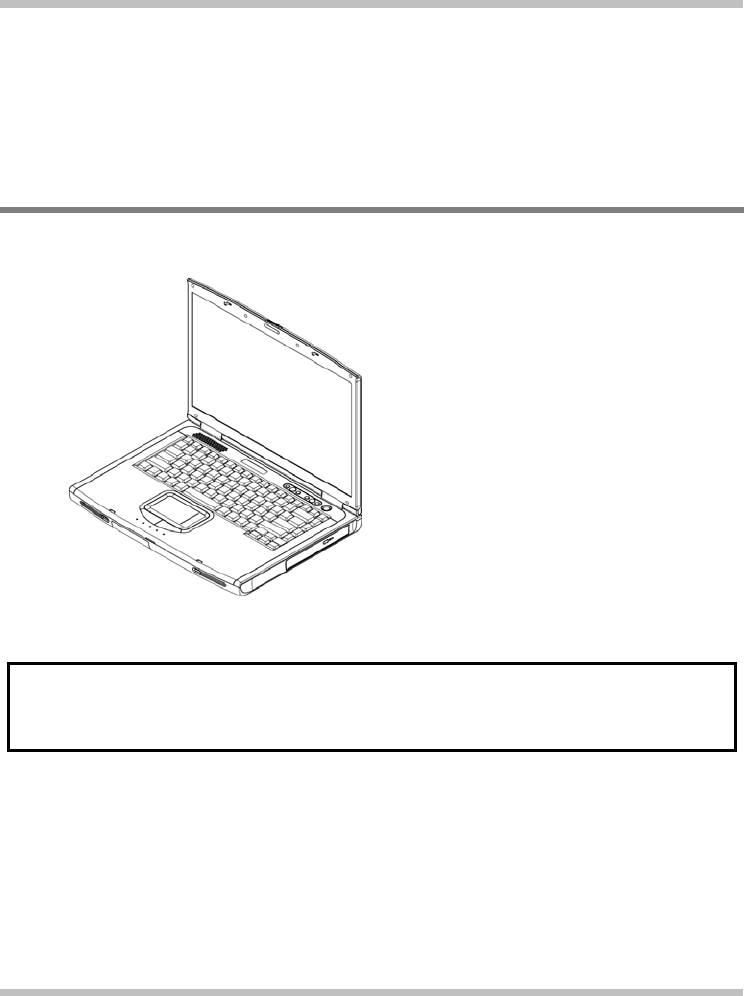
User's Guide Before You Begin
Page 1-1
Chapter 1 Before You Begin
Please read this section before you start using your computer.
1.1 Checking What You Received
Your notebook package should contain the following items:
Note: You should keep the original factory carton and packing materials in case you
need to ship the unit back for servicing.
• The Notebook.
• AC Adapter.
• AC Power Cord.
• CD Disc (Including Drivers and
User’s Guide).
• Battery Pack.
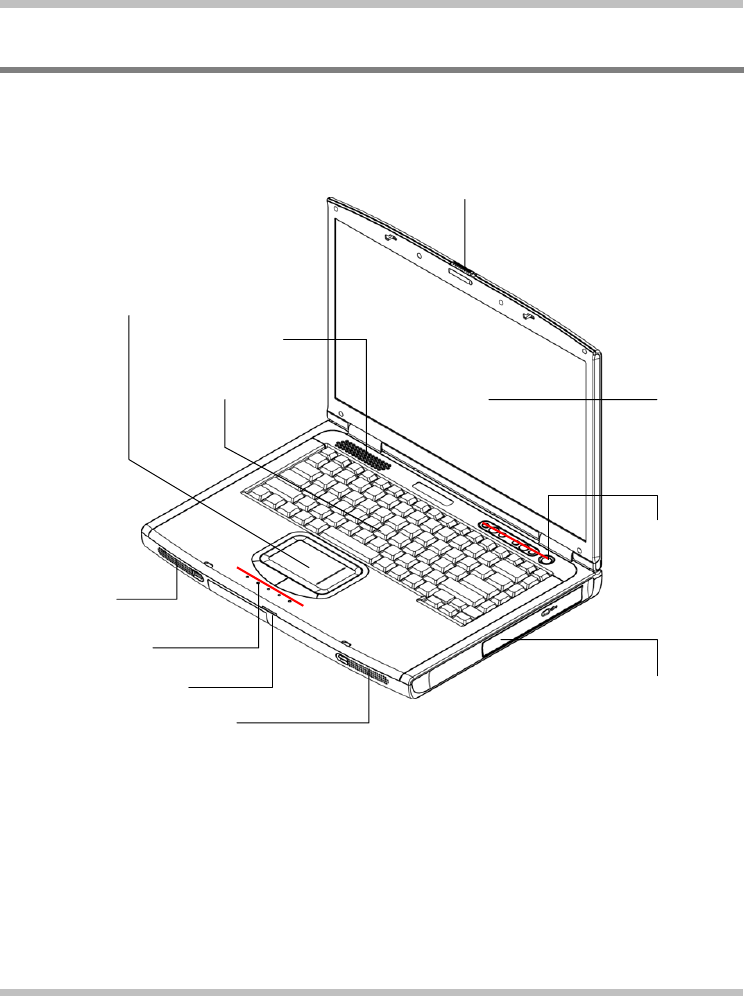
Before You Begin User's Guide
Page 1-2
1.2 Examining Your Computer
Before you start using your computer, you need to get acquainted with your notebook's
main features and interfaces:
Panoramic View
Optical Drive
Ventilation Grills
Keyboard
Touch Pad
LCD
Screen
Speaker
Speaker
Cover Latch
Five Status
LEDs
Seven
S
y
stem Buttons
Two Power LEDs
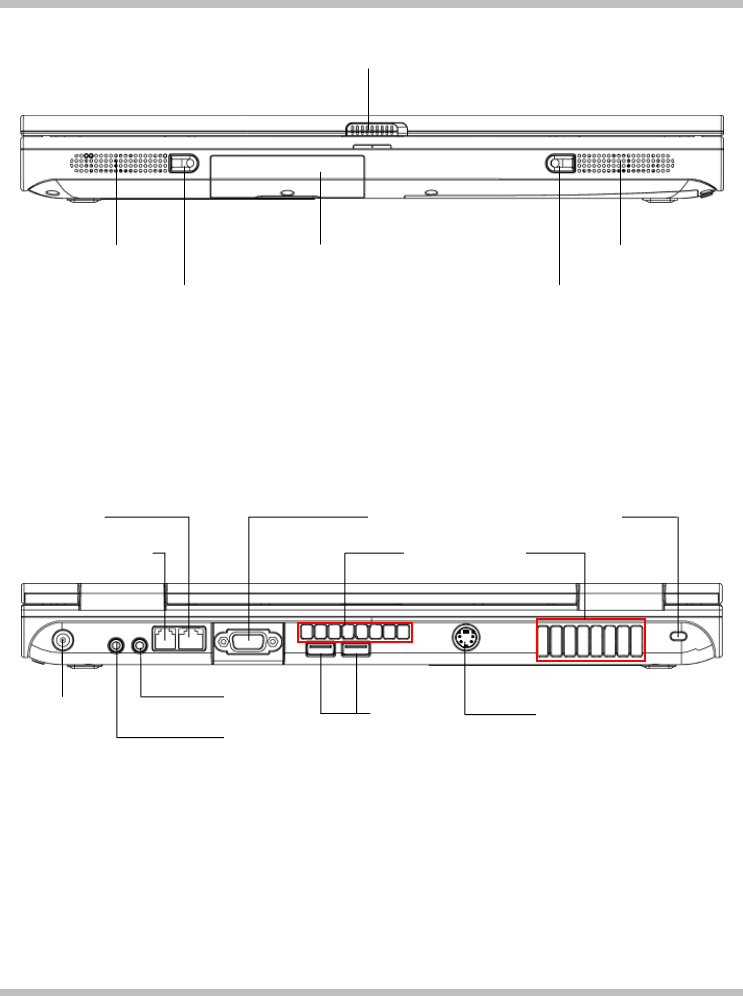
User's Guide Before You Begin
Page 1-3
Front View
Rear View
Cover Latch
Speaker
DC-In
Microphone
Headphone USB Ports
RJ11 Fax/Modem
Connecto
r
RJ45 LAN
Connecto
r
VGA Port
S-Video Connector
(Optional)
Kensington
Lock
Ventilation Grills
Speaker
HDD Drive
Woofer Woofer
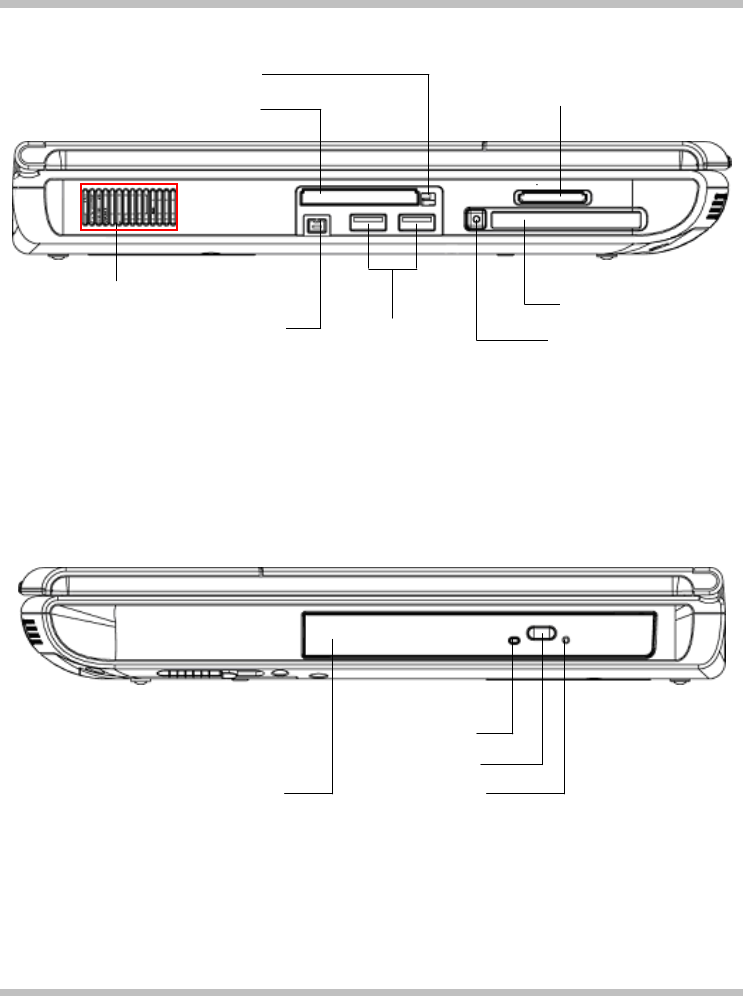
Before You Begin User's Guide
Page 1-4
Left View
Right View
Ventilation Grills
IEEE1394 Connector (Optional) USB Ports PCMCIA
Eject Handle
PCMCIA
Socket Door
CF Card Socket Door
CF Card Eject Handle 4-in-1 Socket Door
(
for MMC/MS/SD/CF Cards
)
Optical Drive
Eject Button
Emergency Hole
ODD LED
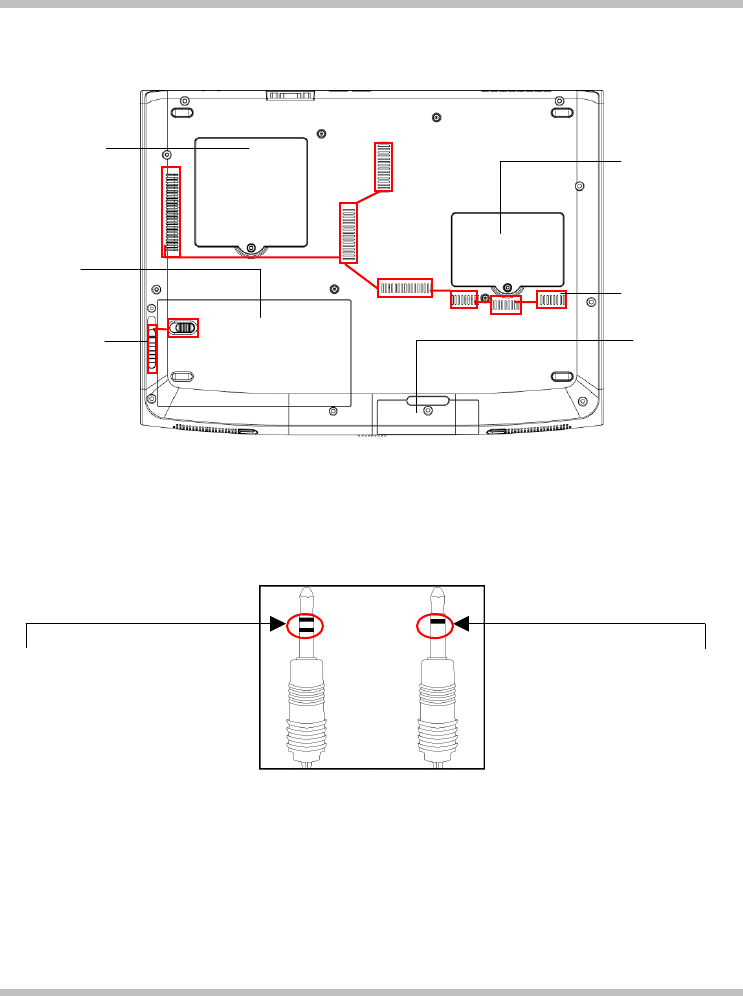
User's Guide Before You Begin
Page 1-5
Bottom View
Two Types for Audio Jet
Mono Connector:
Your microphone jet should
have this type of connecto
r
as shown here.
Stereo Connector:
Your headphone jet should
have this type of connector
as shown here
Two Battery
Latches
Battery
Pack
Mini-PCI
Doo
r
DDR Memory
Doo
r
HDD Door
Ventilation
Grills
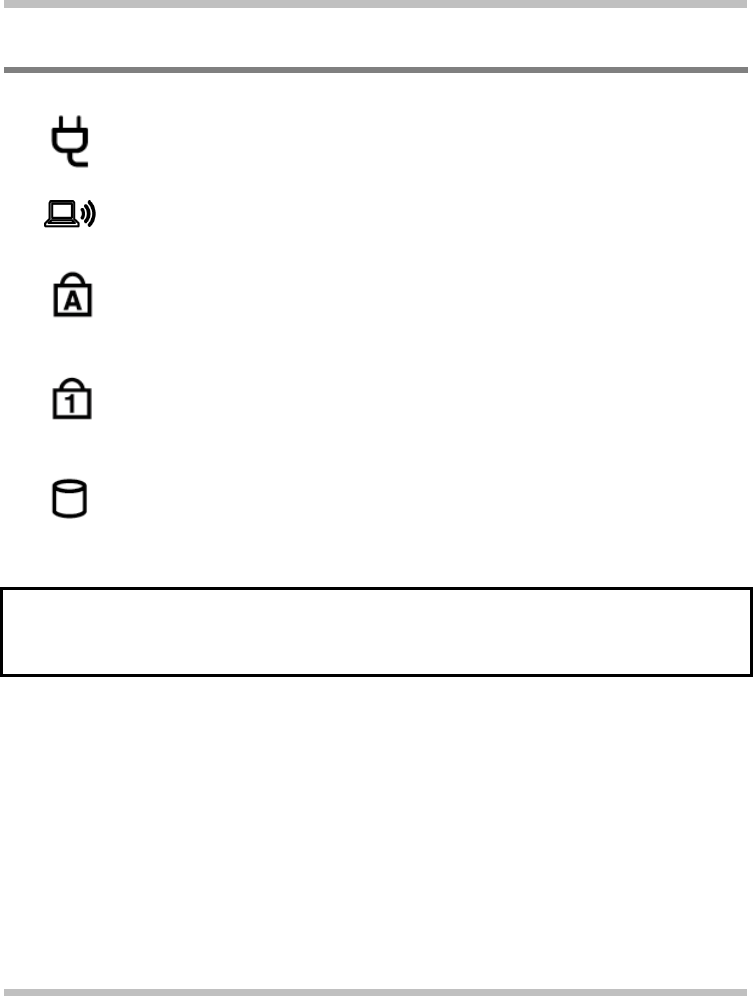
Before You Begin User's Guide
Page 1-6
1.3 The Five Status LEDs
The AC Adapter LED
This LED would be lit when system is connected to an AC adapter.
The Wireless LED
This LED would be lit when the wireless function is activated.
The Caps Lock LED
The LED would be lit when the keyboard is in Caps Lock mode. In this mode,
all characters you type are in uppercase.
The Num Lock LED
This LED would be lit when the keyboard is in Num Lock mode. In this mode,
the embedded numeric keypads can be used.
The HDD Access LED
This LED would be lit when system is accessing the HDD.
Note: The Five Status LEDs are located near the two click buttons of the touch pad.
For exact location, please refer to the Panoramic View diagram in Chapter 1.2.
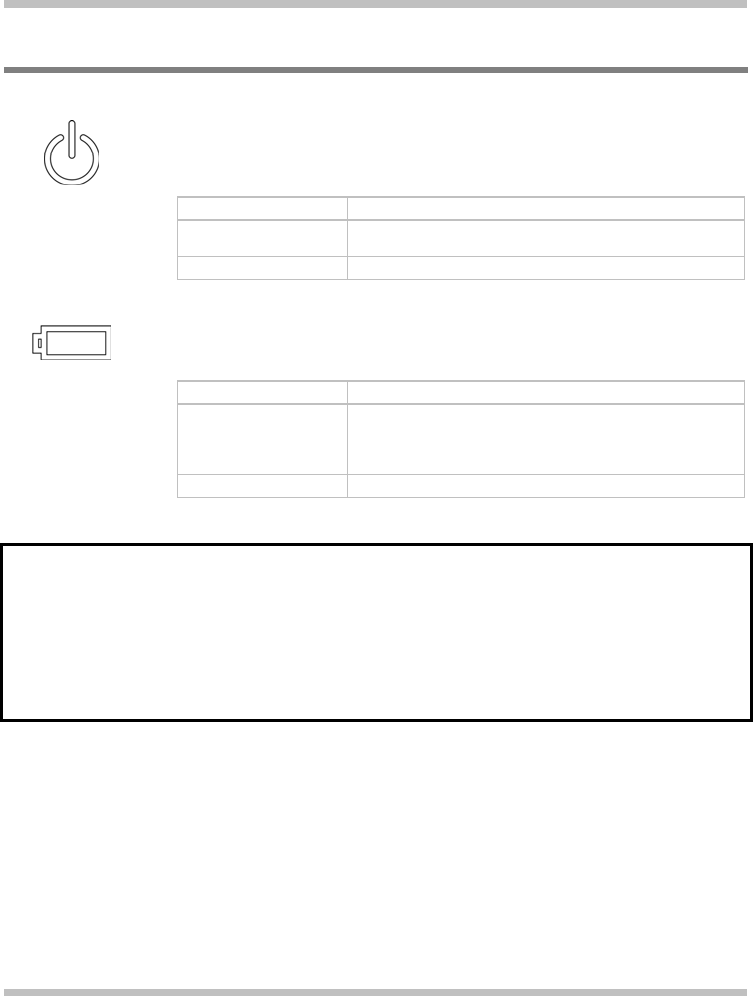
User's Guide Before You Begin
Page 1-7
1.4 The Two Power LEDs
The Power On LED
Below is how the LED would behave in different situations:
Off System is powered off, or in Hibernate mode.
On • System is powered by AC adapter, and/or
• System is in full operation.
Blinking System is in Standby mode.
The Battery Pack LED
Below is how the LED would behave in different situations:
On Battery pack is being recharged: fast-charge or pre-charge.
Blinking • Battery pack is consuming down to 10% level.
• Battery pack is waiting for recharge when battery
temperature is too high after discharge.
• Battery pack error.
Off Battery pack is not under recharge.
Note: The Two Power LEDs are located near the Five Status LEDs. For exact
location, please refer to the Panoramic View diagram in Chapter 1.2.
For more details on Standby and Hibernate, please refer to Power Options (for
Windows Systems) in the Control Panel of your Microsoft Windows operating
system.
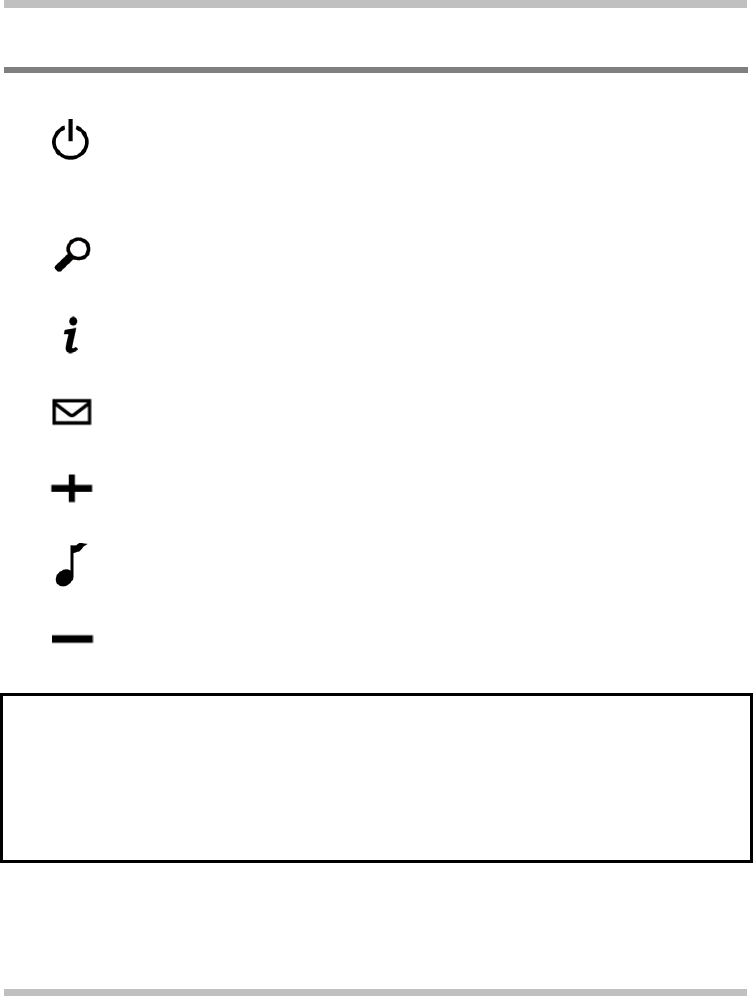
Before You Begin User's Guide
Page 1-8
1.5 The Seven System Buttons
The Power Button
This Power Button is programmable by user. For detail on how to program this
button, please refer to the Power Options of Control Panel in Windows
System.
Search Button
Press this button to activate the search function.
Internet Button
Press this button to activate the internet function.
Email Button
Press this button to activate the email function.
Volume Up Button
Press this button to increase volume.
CD Play Button
Press this button to playback audio CD.
Volume Down Button
Press this button to decease volume.
Note: When the two system buttons, Volume Up Button and Volume Down Button,
are pressed together, the sound volume would be muted.
Note: The Seven System Buttons are located near top right of keyboard. For exact
location, please refer to the Panoramic View diagram in Chapter 1.2.
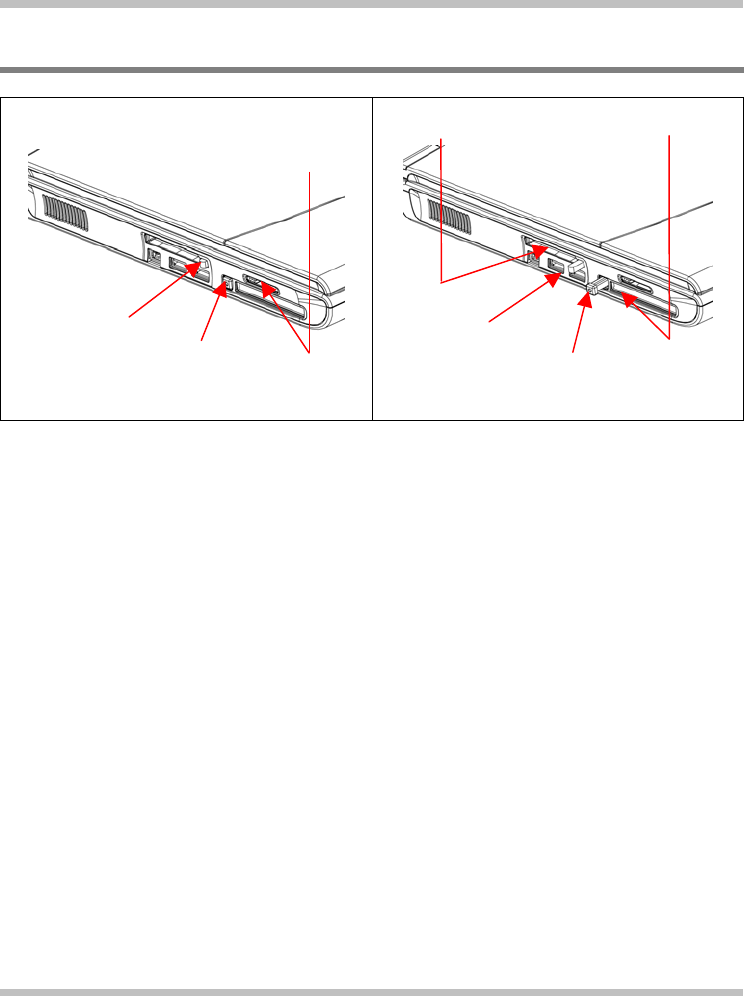
User's Guide Before You Begin
Page 1-9
1.6 Attention On Handles And Socket Doors
Please observe below safety measures:
• Make sure the PCMCIA eject handle does not protrude out at all the time, unless you
are using the handle to eject PCMCIA card. A protruded handle is prone to external
interference; such as ramming by an inkjet printer or external keyboard.
• When PCMCIA card is not inserted into the PCMCIA socket, make sure this socket is
covered by the “PCMCIA socket door” as supplied together with this notebook. The
purpose of this “PCMCIA socket door” is to prevent foreign matters from entering into
the system unit through this socket, when PCMCIA card is not inserted.
• Make sure the CF card eject handle does not protrude out at all the time, unless you are
using the handle to eject CF card. A protruded handle is prone to external interference;
such as ramming by an inkjet printer or external keyboard.
• When CF card is not inserted into the CF card socket, make sure this socket is covered
by the “CF card socket door” as supplied together with this notebook. The purpose of
this “CF card socket door” is to prevent foreign matters from entering into the system
unit through this socket, when CF card is not inserted.
• When no card (Multi-Media Card/Memory Stick/SD Card/CF Card) is not inserted
into this 4-in-1 socket, make sure this socket is covered by the “4-in-1 socket door” as
supplied together with this notebook. The purpose of this “4-in-1 socket door” is to
prevent foreign matters from entering into the system unit through this socket, when no
card is inserted.
The CF card handle
is retracted The PCMCIA
handle is retracted
The CF card handle
is
p
rotruded out The PCMCIA handle is
p
rotruded out.
4-in-1- Slot for
MMC/MS/SD/CF cards
PCMCIA Slot
CF Card Slot
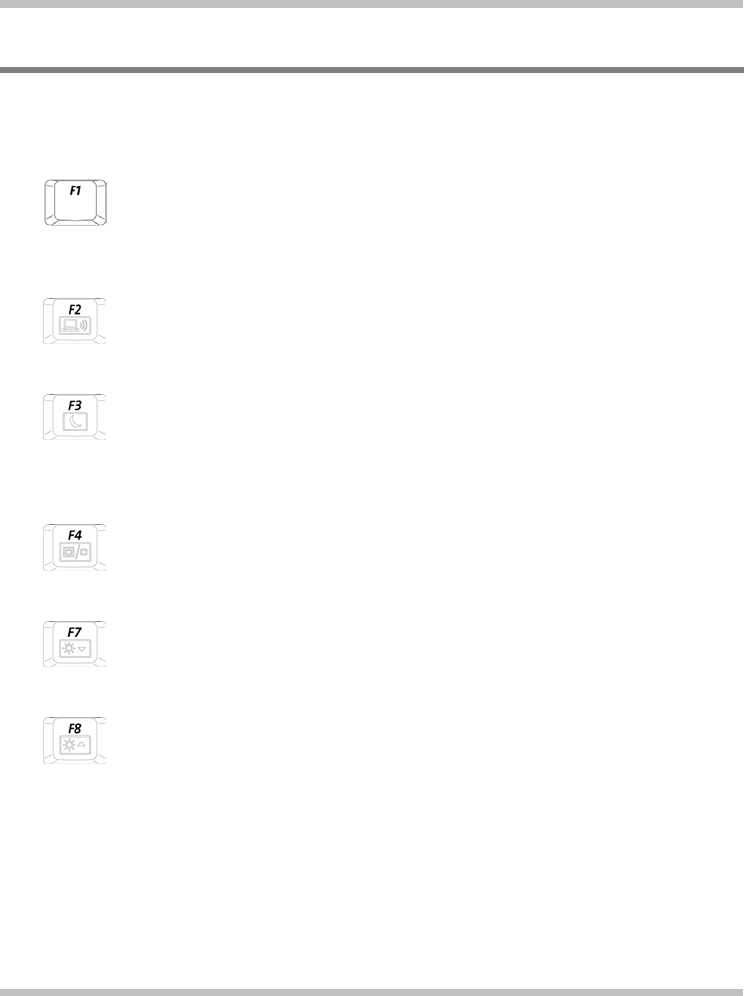
Before You Begin User's Guide
Page 1-10
1.7 The <Fn> Key
The <Fn> Function Key is located near the bottom-left corner of the keyboard. This key is
used together with other keys to activate certain pre-defined functions. To activate these
functions, press and hold down <Fn> together with the keys described below:
LED Toggle
Press this key combination (Fn+F1) would toggle on and toggle off all LED
lights. To minimize visual distractions, you may like to toggle off all LED
lights during DVD software playback.
Wireless LAN
Press this key combination (Fn+F2) to activate the wireless LAN function.
Suspend
Press this key combination (Fn+F3) to have system enter the Suspend mode.
In Suspend mode, the black light of the display panel would be turned off and
a host of internal devices would enter into a stage of lower power
consumption. Press any keycap on the keyboard to resume normal operation.
LCD/CRT Switch
Press this key combination (Fn+F4) to switch between LCD only, CRT only,
and LCD/CRT simultaneously.
Brightness Decrease
Press this key combination (Fn+F7) to decrease the brightness of the LCD
display.
Brightness Increase
Press this key combination (Fn+F8) to increase the brightness of the LCD
display.
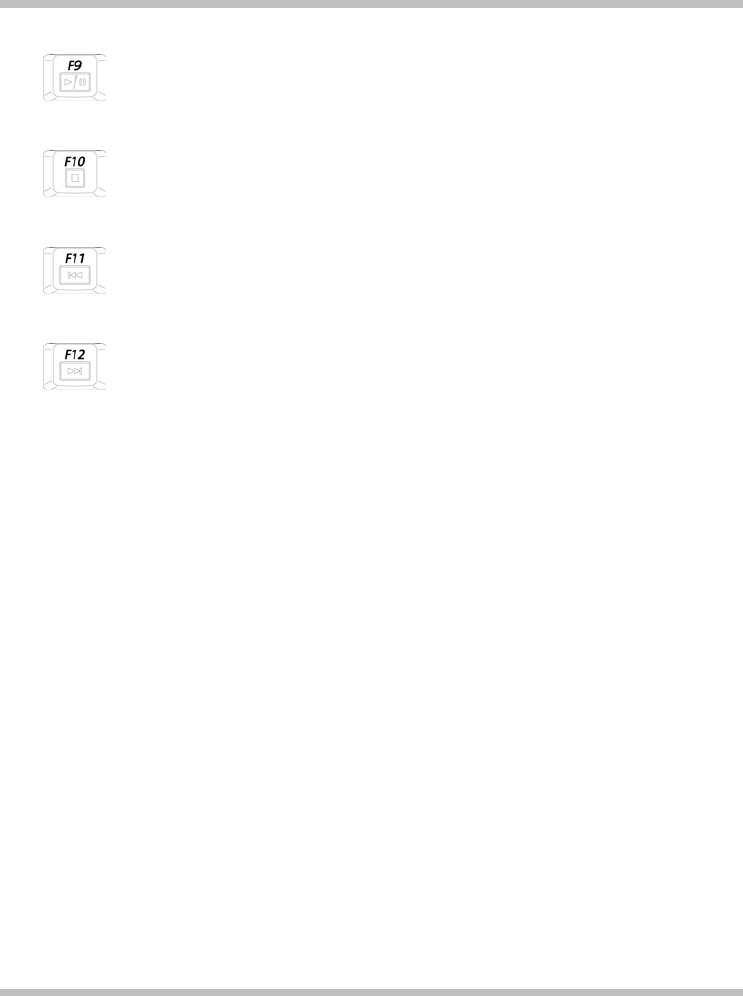
User's Guide Before You Begin
Page 1-11
Play/Pause
This hot-key is for audio CD disc playback. Press this key combination
(Fn+F9) to play or pause audio play back.
Stop
This hot-key is for audio CD disc playback. Press this key combination
(Fn+F10) to stop audio playback.
Previous Track
This hot-key is for audio CD disc playback. Press this key combination
(Fn+F11) to skip to the previous track.
Next Track
This hot-key is for audio CD disc playback. Press this key combination
(Fn+F12) to skip to the next track.
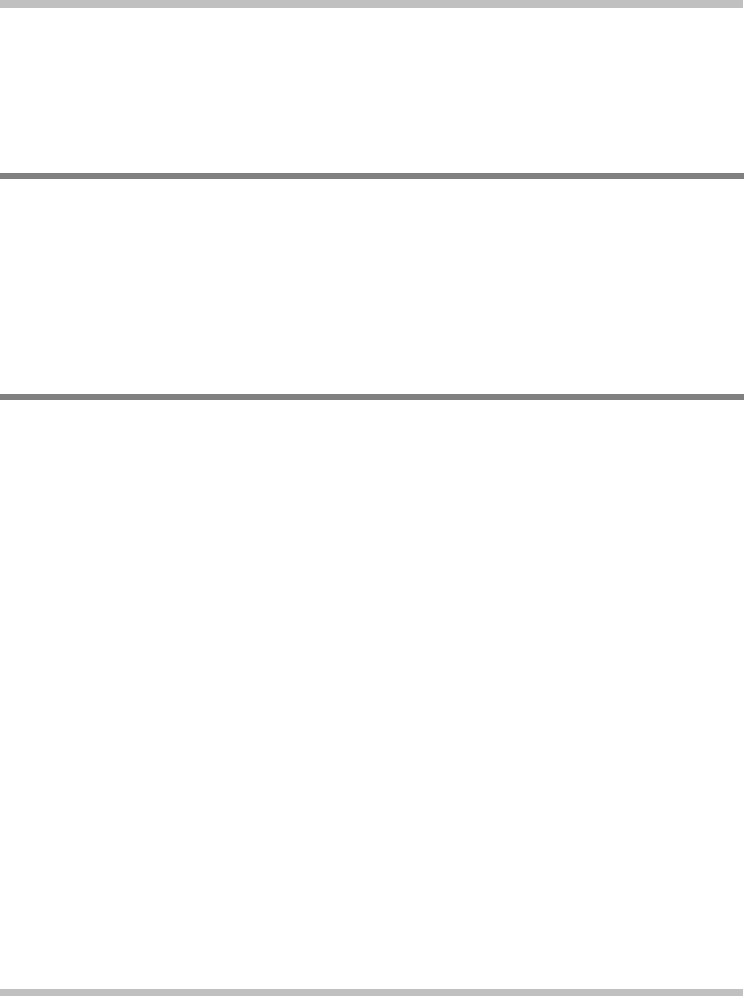
User's Guide Battery
Page 2-1
Chapter 2 Battery
2.1 Battery Pack
Your notebook is equipped with a high energy rechargeable Lithium Ion (Li-Ion) battery
pack. In general, a fully charged battery pack can support around 2.0~3.0 hours of
operation, with Windows’ Power Management option enabled. However, difference in
configuration (CPU, HDD, Memory etc.) and system utilization (especially I/O activities)
can affect the operation time greatly.
2.2 Recharging the Battery Pack
Your notebook supports both on-line and off-line recharge. Follow the procedure below to
recharge battery:
• Make sure the battery pack is installed in the notebook.
• Connect the AC adapter to the notebook and to an electrical outlet.
When a battery pack is being recharged, its battery LED (located near the Five Status
LEDs) would be lit up. For details on the LEDs, please refer to Chapter 1.3. When the
notebook is OFF, a depleted Li-Ion battery will take three hours to recharge.

Battery User's Guide
Page 2-2
2.3 Questions and Answers
Q: I can feel the heat next to the Touch Pad during recharge. Is it normal?
A: The battery will generate heat during recharging and discharging. There is a
protection circuit inside the notebook to prevent overheating. User needs not to
worry.
Q: My battery operation time is not as long as it should be. Why?
A: The battery is heat sensitive and can only be charged to its maximum if the battery
and its environmental temperature remain within 15-25°C (59-77°F). The more the
temperature deviates from this range during recharging, the less chance there is for
the battery to be fully charged. In order to recharge the pack to its full capacity,
users are requested to cool down the unit by unplugging the AC Adapter. Wait until
it is cooled down. Then plug in the AC Adapter to start recharging again.
Q: I did not use my spare battery for a few days. Even though it was fully recharged,
there wasn't as much power left as a newly charged one. Why?
A: The batteries will self-discharge (1% per day for Li-Ion) when they are not being
recharged. To make sure a battery pack is fully charged, recharge before use.
Always keep the battery inside the notebook and have the AC adapter connected
whenever possible.
Q: I did not use my spare battery for months. I have problem in recharging it.
A: If you happen to leave your battery pack to go through an extended period of self-
discharge, say more than three months, the battery voltage level will become too
low and needs to be Pre-Charged (to bring the battery voltage level high enough)
before it automatically (for Li-Ion only) resumes its normal Fast Charge. Pre-
Charge may take 30 minutes. Fast Charge usually takes 2~3 hours.
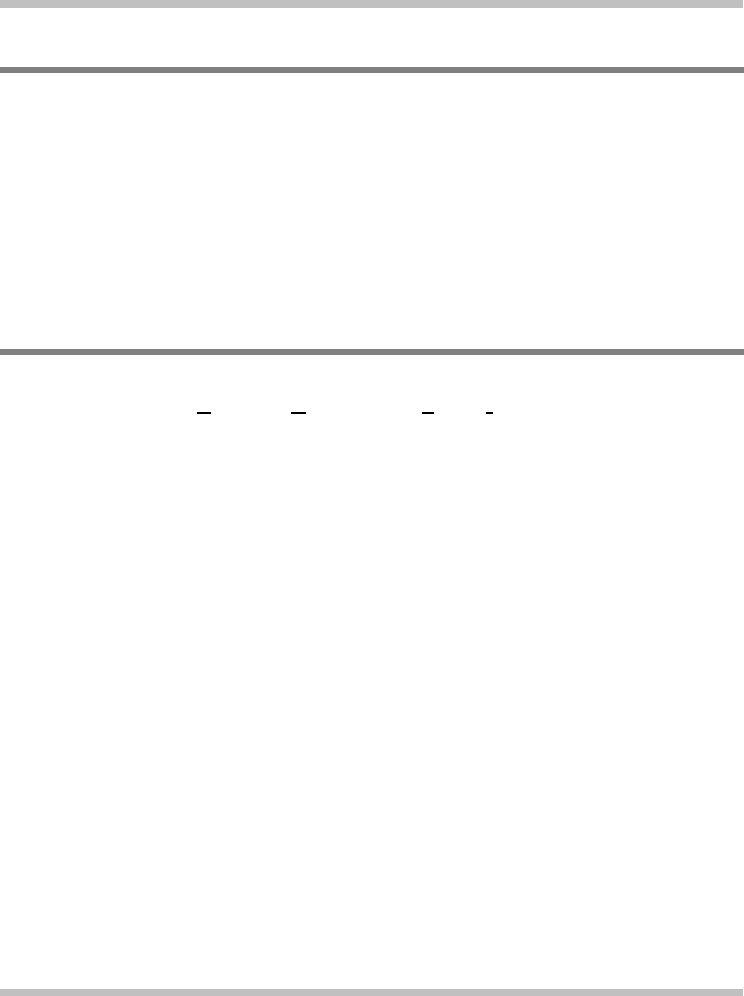
User's Guide Battery
Page 2-3
2.4 Battery Maintenance
To maintain the battery pack's maximum capacity, you should occasionally let the
notebook deplete its battery power completely before recharging.
To carry out a complete depletion of the battery, disconnect the AC adapter and let your
notebook consume the remaining battery power. To speed up the depletion, use the HDD
as much as possible, and the LCD should be set as bright as possible. When the battery is
empty, wait for the notebook to cool down (especially the battery). The temperature should
be within 15-25°C (59-77°F). Then insert the AC adapter to recharge the battery.
2.5 Power Consumption
The Windows® XP, the latest Windows operating systems, has incorporated the latest
state-of-the-art ACPI (Advanced Configuration Power Interface) power management
methodology. In order to fully utilize the power of your battery pack, it would be a good
idea for you to spend sometime to acquire a basic understanding of the power management
concept from your operating system.
In Windows® Operating Systems, you can go through Power Options of the Control
Panel according to the version of Windows® Operating System the notebook applies.
We shall not describe them in details. The Power Options in Windows® XP are further
divided into as below:
• Power Schemes
• Alarms
• Power Meter
• Advanced
• Hibernate
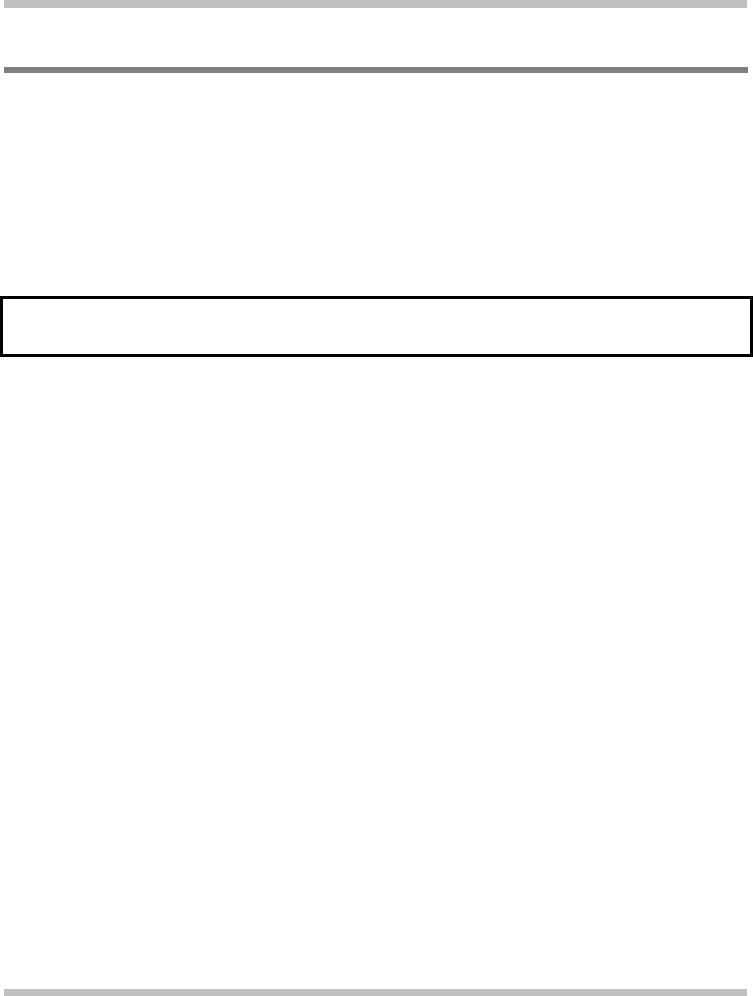
Battery User's Guide
Page 2-4
2.6 Reducing Power Consumption
Although your notebook (together with the operating system) is capable of power
conservation, there are measures you can take to reduce the power consumption:
• Use the AC power whenever possible.
• Lower the intensity of the LCD backlight. A very bright screen translates to higher
power usage.
• Try to use the HDD or the PCMCIA drive to read and write files, instead of using
the external USB FDD.
Note: The battery pack should be locked in the battery compartment all the time.
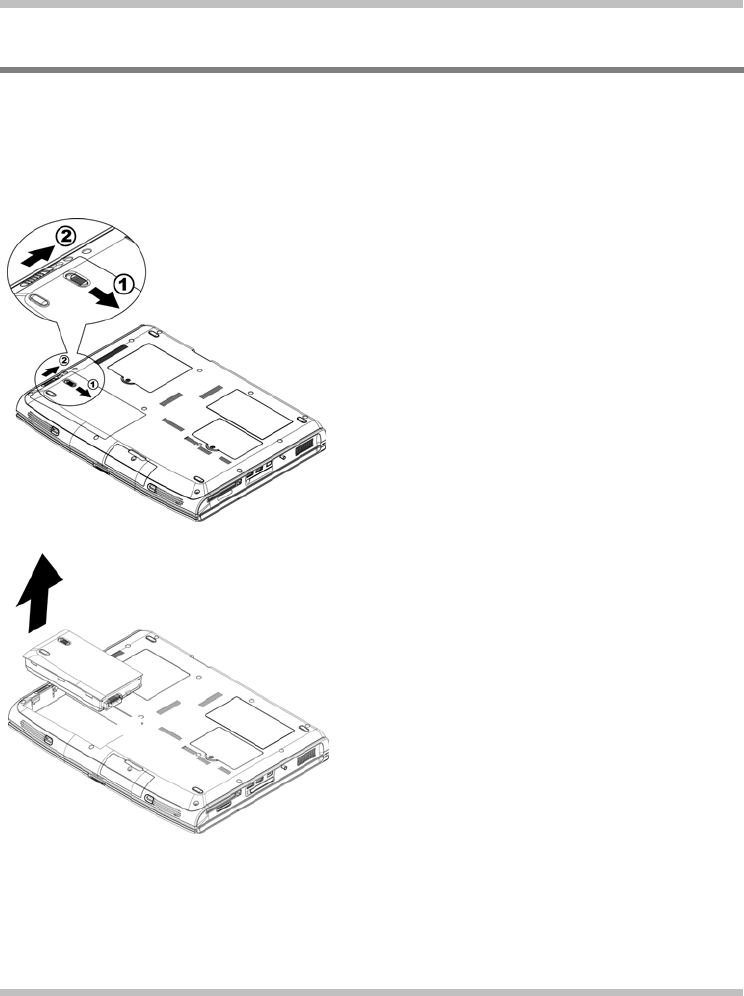
User's Guide Battery
Page 2-5
2.7 Removing The Battery Pack
This battery pack can easily be removed and replaced. Make sure that the computer is
properly shutdown before changing the battery pack. If you would like to change the
battery pack while power is on, make sure this battery pack is not the only electrical source
to the system unit. Follow the steps below to remove the battery pack.
To insert the battery pack, reverse the steps above.
• Make sure the system is properly
shutdown.
• Flip the system upside down.
• Push the two battery latches to the
unlock position as shown by #1 and #2
(Enlarged Diagram).
• Maintain the latch in the unlock position.
• Remove the battery pack as shown.
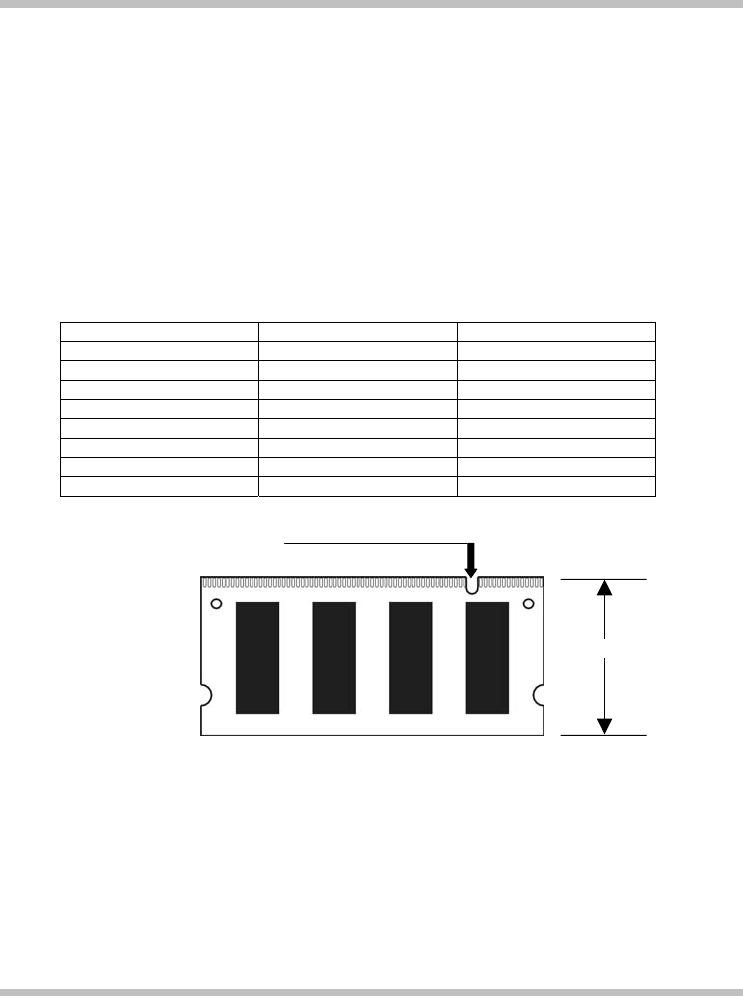
User's Guide Memory
Page 3-1
Chapter 3 Memory
Your notebook is equipped with a configurable memory unit. The industry standard
JEDEC DDR S.O.DIMM memory module socket is available for memory upgrade to
1024MB. The table below illustrates all the possible ways system memory can be
configured.
Two types of DDR S.O.DIMM are available in the market: PC2100 (DDR266) and
PC2700 (DDR333). If it occurs that system is installed with both the PC2100 and PC2700
S.O.DIMM’s, the overall speed would be downgraded to DDR266.
Total Memory In-System Memory SODIMM Memory
256MB 256MB 0MB
384MB 256MB 128MB
512MB 256MB 256MB
768MB 256MB 512MB
512MB 512MB 0MB
640MB 512MB 128MB
768MB 512MB 256MB
1024MB 512MB 512MB
DDR S.O. DIMM Memory Module
Groove for indicating the
orientation of the module
1.25” max
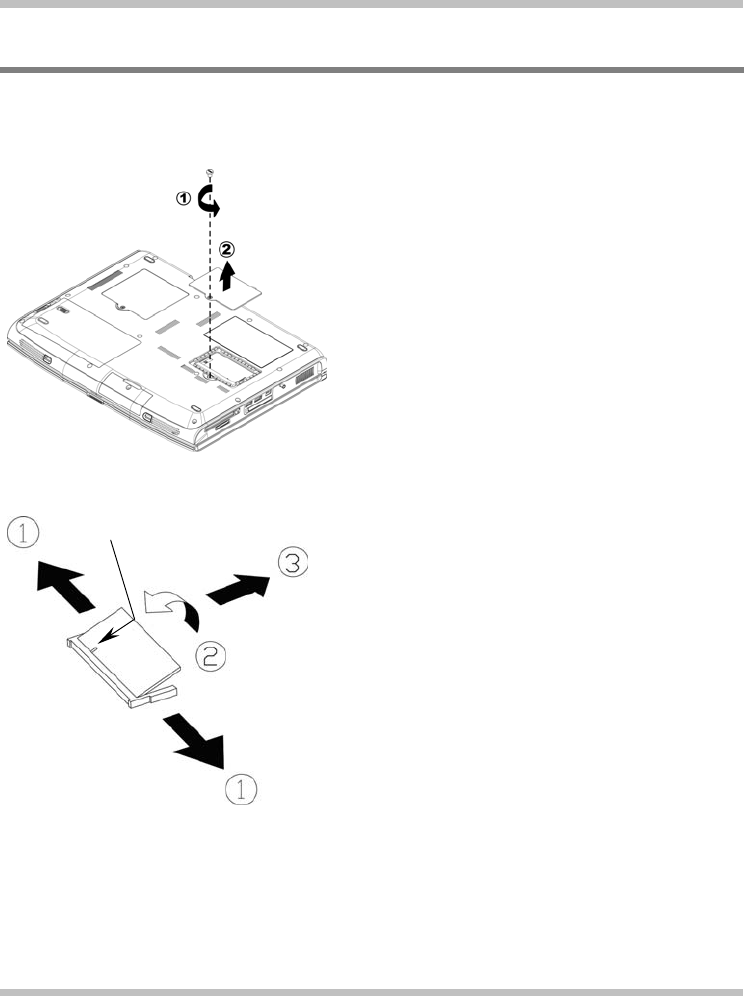
Memory User's Guide
Page 3-2
3.1 Removing Memory Module
Below is the procedure on how to remove the memory module.
To insert the memory module, reverse the steps above.
• Make sure the system is properly
shutdown.
• Flip the system upside down.
• Remove the screw as shown by #1.
• Remove the compartment door as
shown by #2.
The Groove
• Press the spring-locks sideways as
shown by #1.
• The memory module would pop up
as shown by #2.
• Remove the memory module as
shown by #3.
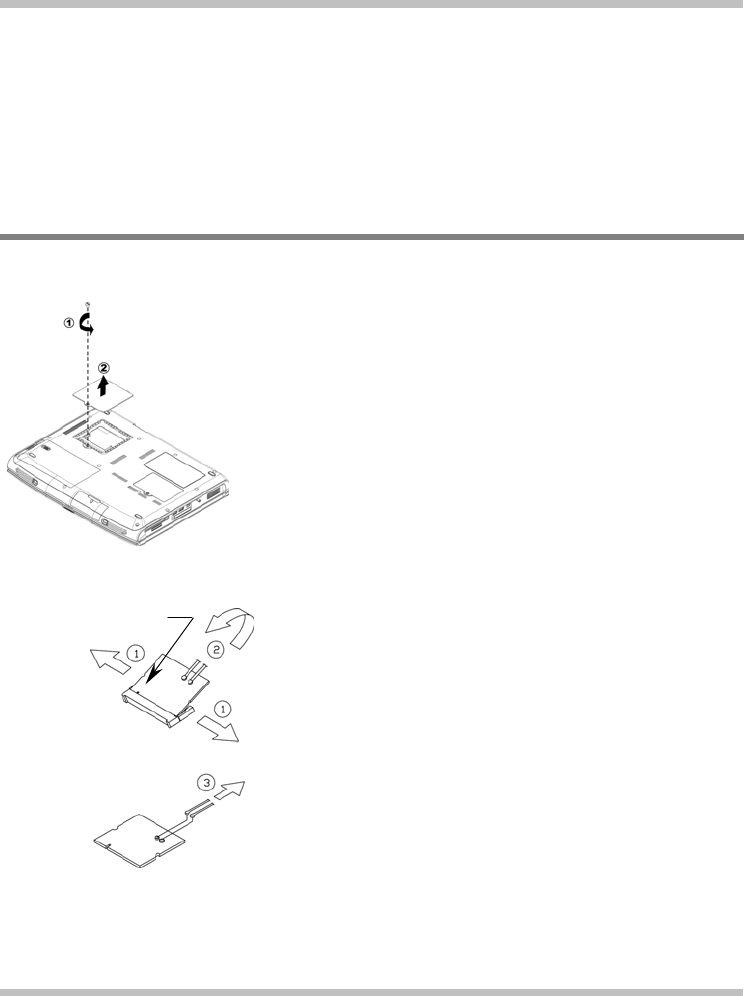
User's Guide Mini-PCI Module
Page 4-1
Chapter 4 Mini-PCI Module
Your notebook is equipped with a Mini-PCI module. The Mini-PCI supports wireless
LAN function.
4.1 Removing Mini-PCI Module
Below is the procedure on how to remove the Mini-PCI module.
To insert the Mini-PCI module, reverse the steps above.
• Make sure the system is properly
shutdown.
• Flip the system upside down.
• Remove the screw as shown by #1.
• Remove the compartment door as
shown by #2.
The Groove
• Press the spring locks sideways as
shown by #1.
• The Mini-PCI module would pop up as
shown by #2.
• Disconnect the two cables as shown by
#3. Note, there are two types of mini-PCI
module. Externally, they look slightly
different; especially on the locations of
the cable connections.
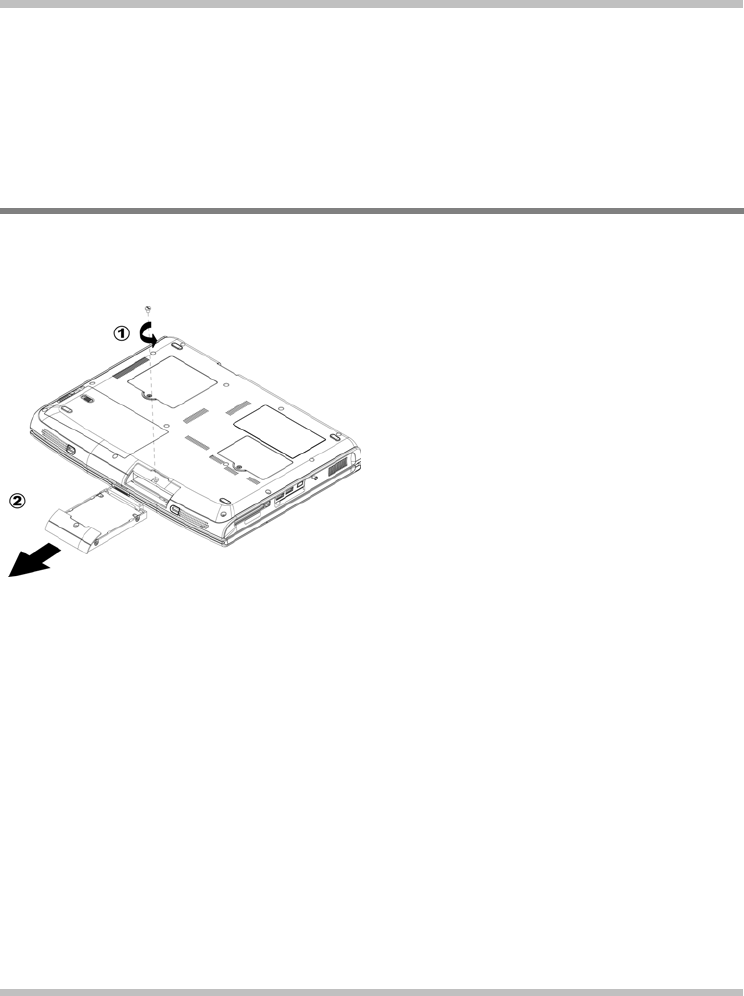
User's Guide The HDD Drive
Page 5-1
Chapter 5 The HDD Drive
Your notebook is equipped with an industry standard 2.5”/9.5mm hard disk drive.
5.1 Removing The Hard Disk Drive
Below is the procedure on how to remove the hard disk drive.
To insert the hard disk drive, reverse the steps above.
• Make sure the system is properly
shutdown.
• Flip the system upside down.
• Remove the screw as shown by
#1.
• Remove the HDD drive as shown
by #2.
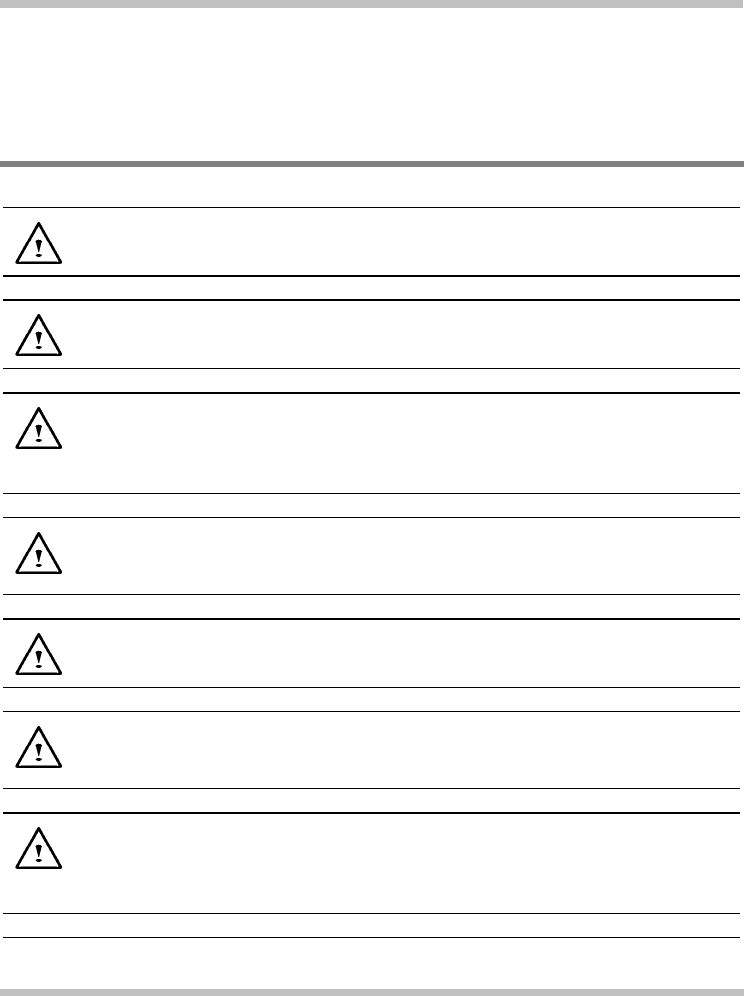
User’s Guide Appendix A
Page A-1
Appendix A- Agency Regulatory Notices
A.1 Safety Instructions
CAUTION: Please read these safety instructions carefully.
CAUTION: Please keep this User's Manual for future reference.
CAUTION: Please disconnect this equipment from AC outlet before
cleaning. DO NOT use liquid or sprayed detergent for cleaning. Use a clean
moistened cloth.
CAUTION: The wall socket used should be positioned near the equipment
and should be easily accessible.
CAUTION: Please keep this equipment free from humidity.
CAUTION: Place the equipment on a reliable surface at all times. A drop or
fall can cause severe damage.
.
WARNING: The openings of the enclosure are for air ventilation and are
meant to protect the equipment from overheating. DO NOT COVER THE
VENTILATION OPENINGS.
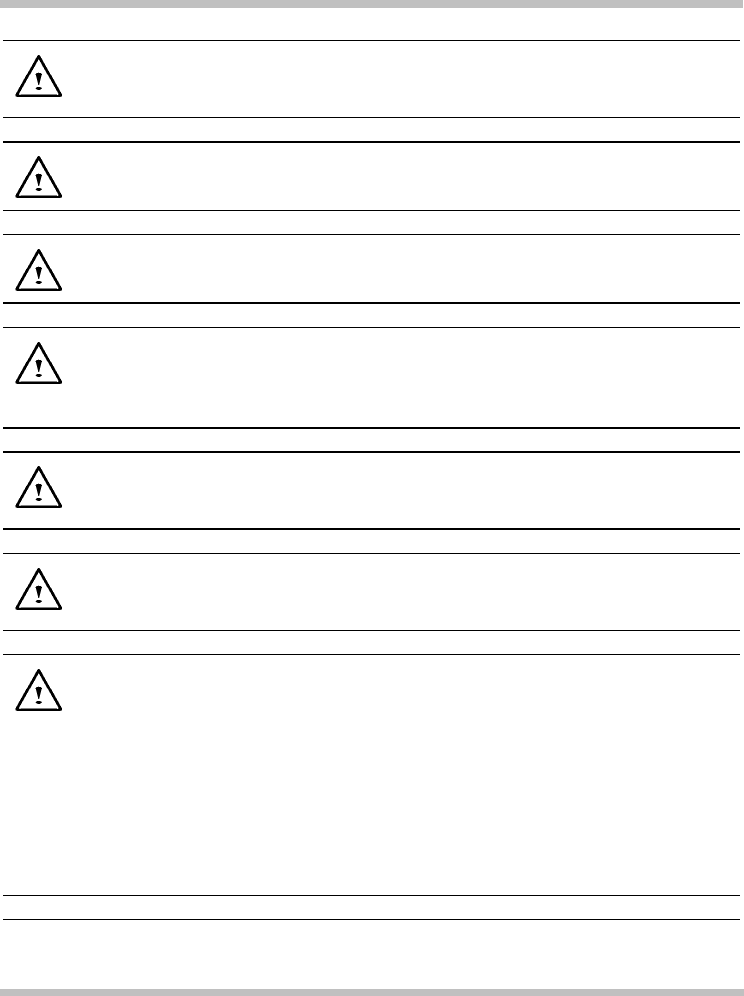
Appendix A User's Guide
Page A-2
CAUTION: Verify the voltage of the power source before connecting the
unit to any power outlet.
WARNING: DO NOT step on or place anything over the power cord.
CAUTION: All cautions and warnings on the equipment should be noted.
WARNING: If the equipment is not used for a long period of time,
disconnect the equipment from the power source to avoid damage from power
spikes.
WARNING: NEVER pour any liquid into any openings; a fire or electrical
shock is possible.
WARNING: For safety reasons, other than pre-designated ports, doors, and
the equipment should be opened only through qualified service personnel.
CAUTION: If one of the following situations should arise, the equipment
should be checked by an authorized technician:
a. The power cord or plug is damaged.
b. Liquid has penetrated into the equipment.
c. The equipment has been exposed to excessive moisture.
d. The equipment does not work well, or you fail to get it to work
according to user's manual.
e. The equipment has been dropped or damaged.
f. The equipment has obvious signs of breakage.
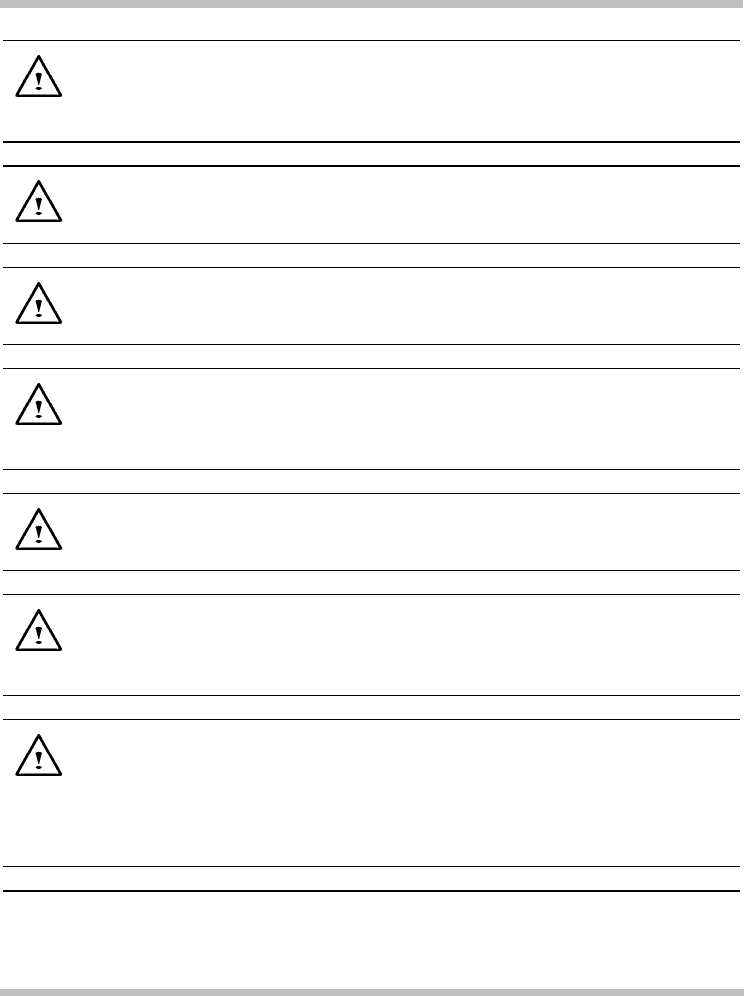
User’s Guide Appendix A
Page A-3
CAUTION: DO NOT LEAVE THE EQUIPMENT IN TEMPERATURES
BELOW -20ºC(-4ºF) OR ABOVE 60ºC(140ºF). IT MAY CAUSE
DAMAGE TO THE EQUIPMENT.
WARNING: Never install modem/telephone wiring during a lightning
storm.
WARNING: Never install modem/telephone jacks in wet locations unless
the jack is specially designed for wet locations.
WARNING: Never touch un-insulated modem/telephone wires or terminals
unless the modem/telephone line has been disconnected at the network
interface.
CAUTION: Use caution when installing or modifying modem/telephone
lines.
WARNING: Avoid using a modem/telephone (other than a cordless type)
during an electrical storm. There may be a remote risk of electric shock from
lightning.
WARNING: This computer contains an internal lithium battery-powered
real-time circuit. There is a risk of explosion and injury if the battery is
incorrectly replaced or handled. Do not attempt to recharge, disassembled,
immerse in water, or dispose of it in fire. Replacement should be done through
your notebook dealer.
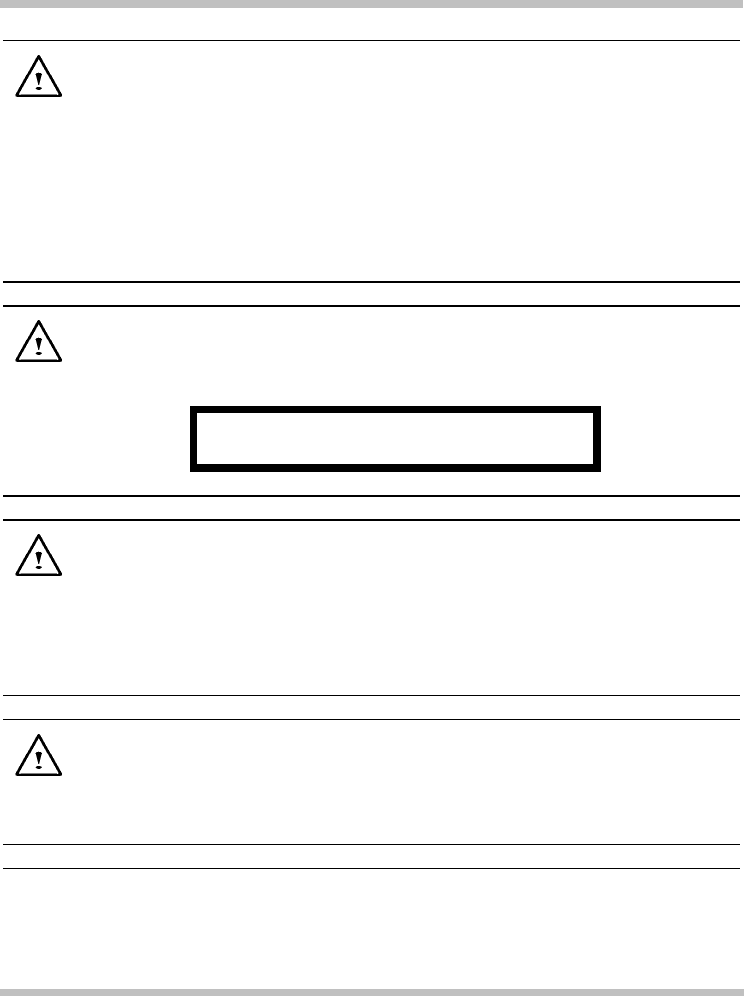
Appendix A User's Guide
Page A-4
WARNING: THE CD-ROM/DVD-ROM IN THIS NOTEBOOK
EMPLOYS A LASER SYSTEM.
a. To ensure proper use of this product, please read the relevant
instructions carefully and retain for future reference.
b. Should the unit ever require maintenance, contact your local dealer.
c. Use of controls, adjustments or the performance of procedures other
than those specified may result in hazardous radiation exposure.
d. To prevent direct exposure to Laser Beam, do no try to open the
enclosure.
CAUTION: The internal CD-ROM/DVD-ROM drive is classified as a
CLASS 1 LASER PRODUCT. Label is located on the outside of the CD-
ROM/DVD-ROM drive with the following wordings:
CLASS 1 LASER PRODUCT
KLASSE 1 LASER PRODUKT
WARNING: Danger of explosion if battery is incorrectly replaced. Replace
only with the same or equivalent type recommended by the manufacturer.
Dispose of used batteries according to the manufacturer’s instructions.
Explosionsgefahr bei unsachgemäßen Austausch der Batterie. Ersatz nur durch
denselben oder einem vom Hersteller empfohlenem ähnlichen Typ. Entsorgung
gebrauchter Batterien nach Angaben des Herstellers.
WARNING: Your notebook contains a Ni-MH or Li-Ion battery pack.
There is a risk of fire and chemical burn if the battery pack is handled
improperly. Do not disassemble, crush, puncture, short external contact, dispose
of in water or fire, or expose it to temperature higher than 60ºC.
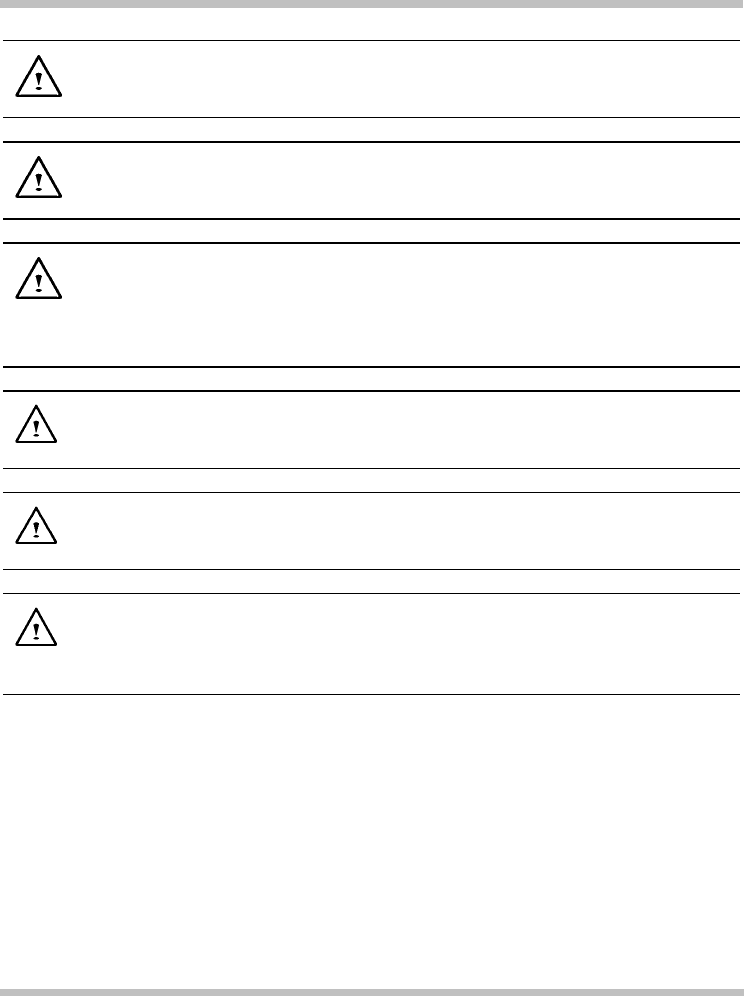
User’s Guide Appendix A
Page A-5
WARNING: Handle the battery pack very carefully. Avoid touching the
metal leads on the connector of the battery case.
CAUTION: Use only approved AC Adapter with your notebook. Using the
wrong type of AC Adapter may cause serious damage to your notebook.
CAUTION: The AC Adapter can accept a line voltage ranging from 100V to
240V and is compatible with most international power sources. If you are
unsure whether your power source is compatible, please contact the local dealer
for assistance.
CAUTION: To reduce the risk of fire, use only No. 26 AWG or larger
telecommunication line cord.
CAUTION: For Continued Protection Against Risk of Fire, Replace Only
with same Type and Rating of Fuse.
CAUTION: If the computer is not sold to German area, please use only the
local recognized power supply cords that are recommended by the
manufacturer.

Appendix A User's Guide
Page A-6
A.2 Agency Notice
Federal Communications Commission Notice
This equipment has been tested and found to comply with the limits for a Class B digital
device, pursuant to part 15 of the FCC Rules. These limits are designed to provide
reasonable protection against harmful interference in a residential installation. This
equipment generates, uses and can radiate radio frequency energy and, if not installed and
used in accordance with the instructions, may cause harmful interference to radio
communications.
However, there is no guarantee that interference will not occur in a particular installation. If
this equipment does cause harmful interference to radio or television reception, which can
be determined by turning the equipment off and on, the user is encouraged to try to correct
the interference by one or more of the following measures:
• Reorient or relocate the receiving antenna.
• Increase the separation between the equipment and receiver.
• Connect the equipment into an outlet on a circuit different from that to which the
receiver is connected.
• Consult the dealer or an experienced radio or television technician for help.
Modifications
The FCC requires the user to be notified that any changes or modifications made to this
device that are not expressly approved by the manufacturer responsible for compliance may
void the user’s authority to operate the equipment.
Cables
Connections to this device must be made with shielded cables with metallic RFI/EMI
connector hoods to maintain compliance with FCC Rules and Regulations.
FCC RF Radiation Exposure Statement
• This transmitter must not be co-located or operating in conjunction with any other
antenna or transmitter.
• This equipment complies FCC RF radiation exposure limits set forth for an
uncontrolled environment. This equipment should be installed and operated with a
minimum distance 0f 20 centimeters between the radiator and your body.

User’s Guide Appendix A
Page A-7
USA and Canada Safety Requirements And Notices
The FCC with its action in ET Docket 93-62 has adopted a safety standard for human
exposure to radio frequency (RF) electromagnetic energy emitted by FCC certified
equipment. The Intel PRO/Wireless LAN MiniPCI Adapter products meet the Human
Exposure limits found in OET Bulletin 65, 2001, and ANSI/IEEE C95.1, 1992. Proper
operation of this radio according to the instructions found in this manual will result in
exposure substantially below the FCC’s recommended limits.
The following safety precautions should be observed:
• Do not touch or move antenna while the unit is transmitting or receiving.
• Do not hold any component containing the radio such that the antenna is very close or
touching any exposed parts of the body, especially the face or eyes, while transmitting.
• Do not operate the radio or attempt to transmit data unless the antenna is connected; if
not, the radio may be damaged.
Use in specific environments:
• The use of wireless devices in hazardous locations is limited by the constraints posed
by the safety directors of such environments.
• The use of wireless devices on airplanes is governed by the Federal Aviation
Administration (FAA).
• The use of wireless devices in hospitals is restricted to the limits set forth by each
hospital.
Antenna use:
• In order to comply with FCC RF exposure limits, low gain integrated antennas should
be located at a minimum distance of 20 cm (8 inches) or more from the body of all
persons.
• High-gain, wall-mount, or mast-mount antennas are designed to be professionally
installed and should be located at a minimum distance of 30 cm (12 inches) or more
from body of all persons. Please contact your professional installer, VAR, or antenna
manufacturer for proper installation requirements.
Explosive Device Proximity Warning
Warning: Do not operate a portable transmitter (such as a wireless network device) near
unshielded blasting caps or in an explosive environment unless the device has been
modified to be qualified for such use.
Use On Aircraft Caution
Caution: Regulations of the FCC and FAA prohibit airborne operation of radio-frequency
wireless devices because their signals could interfere with critical aircraft instruments.
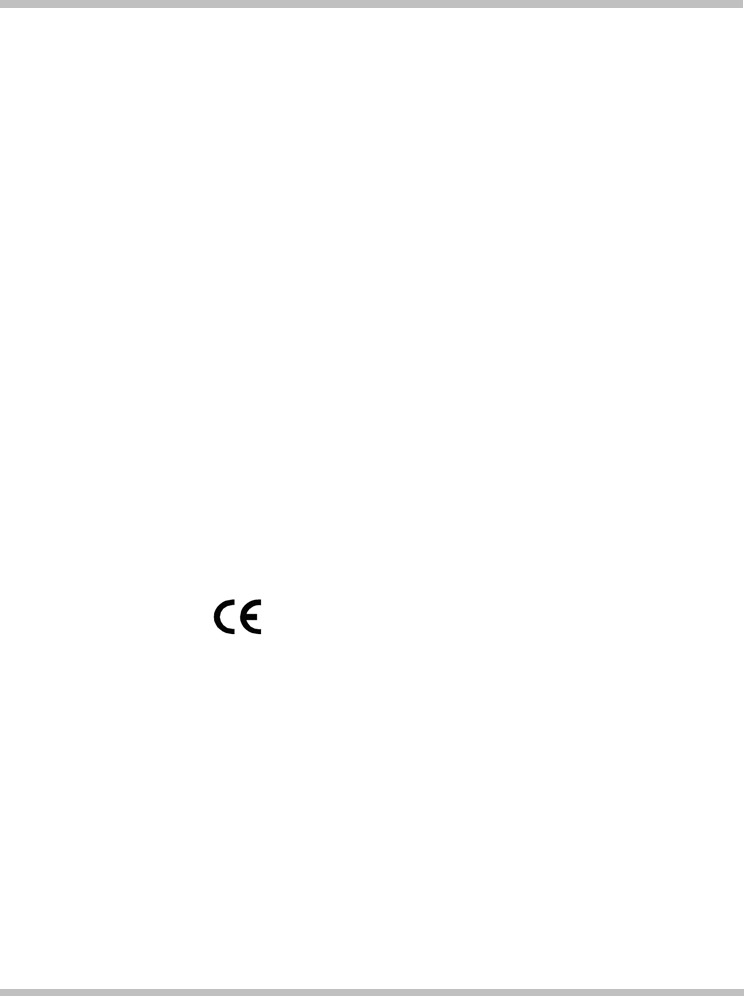
Appendix A User's Guide
Page A-8
Canadian Notice
This Class B digital apparatus meets all requirements of the Canadian Interference-Causing
Equipment Regulations.
Avis Canadien
Cet appareil numerque de la classe B respecte toutes les exigences du Reglement sur le
materiel brouilleur du Canada.
Canada Radio Frequency Interference Requirements
This Class B digital apparatus complies with Canadian ICES-003, Issue 2, and RSS-210,
Issue 4 (Dec. 2000).
“To prevent radio interference to the licensed service, this device is intended to be operated
indoors and away from windows to provide maximum shielding. Equipment (or its transmit
antenna) that is installed outdoors is subject to licensing.”
Cet appareil numérique de la classe B est conforme à la norme NMB-003, No. 2, et CNR-
210, No. 4 (Dec. 2000).
“Pour empêcher que cet appareil cause du brouillage au service faisant l’objet d’une
licence, il doit être utilizé à l’intérieur et devrait être placé loin des fenêtres afin de fournir
un écran de blindage maximal. Si le matériel (ou son antenne d’émission) est installé à
l’extérieur, il doit faire l’objet d’une licence.”
European Union Notice
Product with the CE Marking comply with the EMC Directive (89/336/EEC) and the Low
Voltage Directive (73/23/EEC) issued by the Commission of the European Community and
if this product has telecommunication functionality, the R&TTE Directive (1999/5/EC).
Compliance with these directives implies conformity to the following European Norms (in
parentheses are the equivalent international standards and regulations):
• EN55022 (CISPR 22) Electromagnetic Interference
• EN55024 (IEC61000-4-2,3,4,5,6,8,11) Electromagnetic Immunity
• EN61000-3-2 (IEC61000-3-2)-Power Line Harmonics
• EN61000-3-3 (IEC61000-3-3)-Power Line Flicker
• EN60950 (IEC60950) Product Safety
For devices with built-in wireless equipment, the following additional standards apply:
• ETSI301489-17: General Emissions for Radio Equipment
• EN60950: Safety
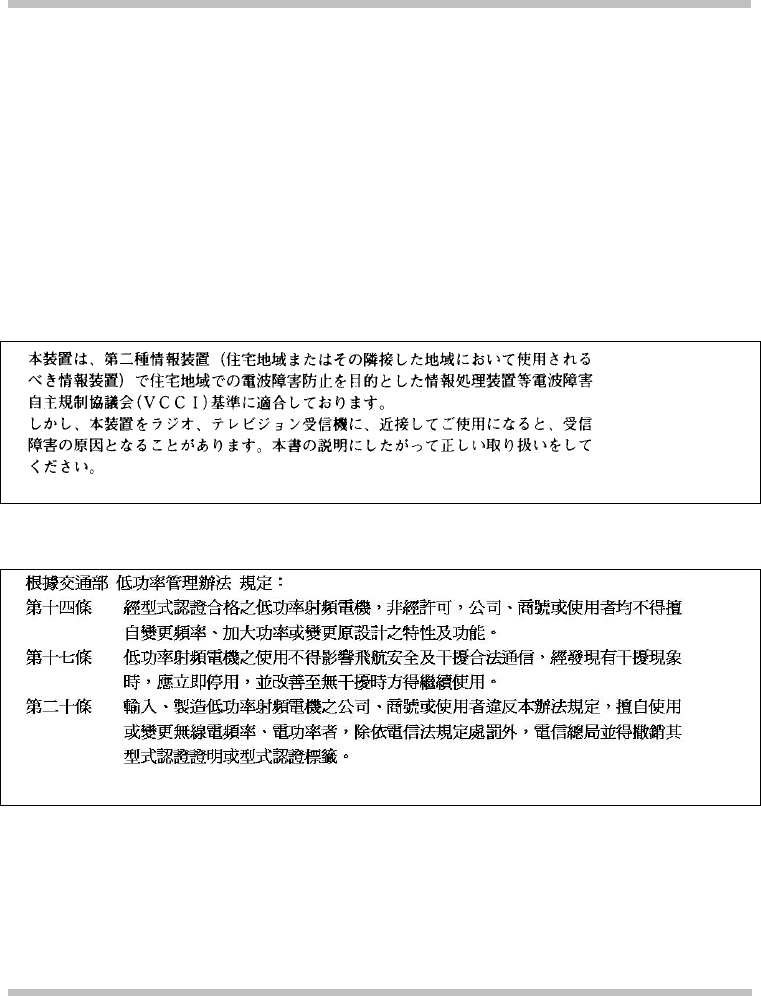
User’s Guide Appendix A
Page A-9
• ETSI300328-2: Technical Requirements for Radio Equipment
CE Caution: Due to the fact that the frequencies used by 802.11b wireless LAN
devices may not yet be harmonized in all countries, 802.11b products are designed for use
only in specific countries or regions, and are not allowed to be operated in countries or
regions other than those of designated use. As a user of these products, you are responsible
for ensuring that the products are used only in the countries or regions for which they were
intended and for verifying that they are configured with the correct selection of frequency
and channel for the country or region of use. And deviation from permissible settings and
restrictions in the country or region of use could be an infringement of local law and may
be punished as such.
Japanese Notice
DGT Statement
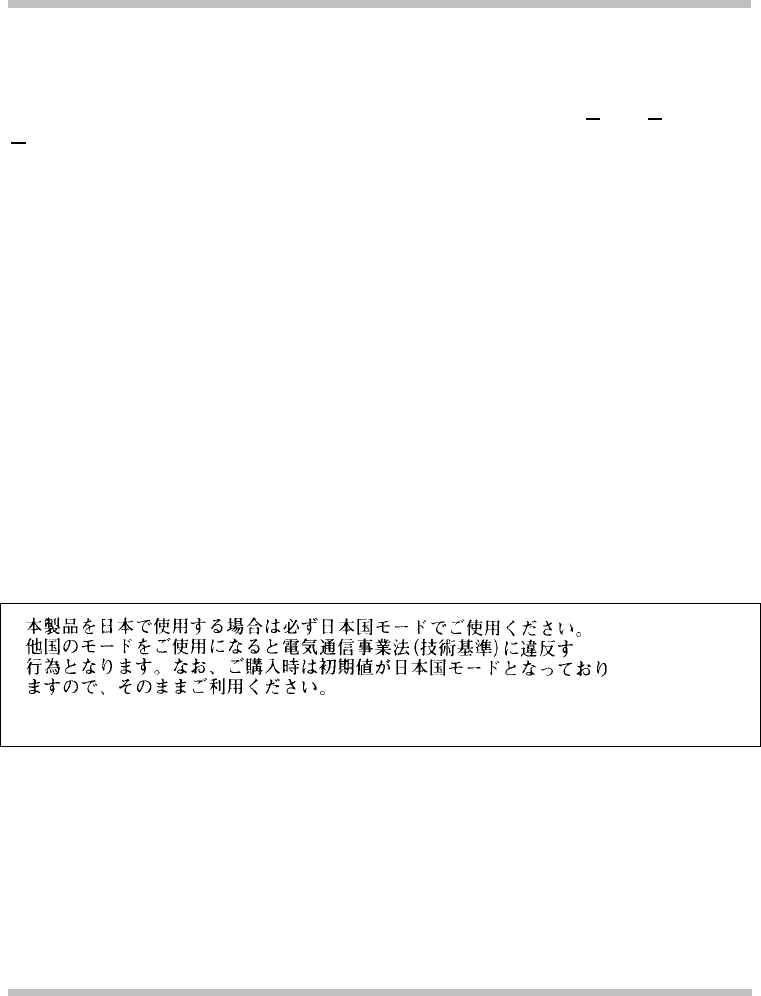
Appendix A User's Guide
Page A-10
U.S. Regulations Governing the Use of Modems
This equipment complies with Part 68 of the FCC Rules. On this equipment is a label that
contains, among other information, the FCC registration number and Ringer Equivalence
Number (REN) for this equipment. You must, upon request, provide this information to
your telephone company.
If your telephone equipment harms the telephone network, the Telephone Company may
discontinue your service temporarily. If possible, they will notify in advance. But, if
advance notice is not practical, you will be notified as soon as possible. You will be
informed of your right to file a compliant with the FCC.
Your telephone company may make changes in its facilities, equipment, operations, or
procedures that could affect proper operation of your equipment. If they do, you will be
notified in advance to give you an opportunity to maintain uninterrupted telephone service.
The FCC prohibits this equipment to be connected to party lines or coin-telephone service.
In the event that this equipment should fail to operate properly, disconnect the equipment
from the phone line to determine if it is causing the problem. If the problem is with the
equipment, discontinue use and contact your dealer or vendor.
The FCC also requires the transmitter of a FAX transmission be properly identified (per
FCC Rules Part 68, Sec 68.381 (C) (3)).
Japanese Modem Notice
U.K. Modem Compliance Information
This modem is approved by the secretary of state at the Department of Trade and Industry
for connection to a single exchange line of the public switched telephone network run by
certain licensed public telecommunication operators or system connected there to (Direct
exchange lines only, not shared service or 1-1 carrier systems).

User’s Guide Appendix A
Page A-11
This modem is also suitable for connection to Private Automatic Branch Exchange (PABX),
which return secondary proceeding indication.
If this modem is to be used with a PBX which has extension wiring owned by BT,
connection of the modem the PBX can only be carried out by BT; or by the authorized
maintainer of the PBX unless the authorized maintainer has been given 14 days written
notice that the connection is to be made by another person; and that period of notification
has expired.
This modem is suitable for use only on telephone lines proved with Loop Disconnect or
Multi-Frequency Dialing Facilities.
Users of this modem are advised that the approval is for connection to the PSTN via the
telephone line interface supplied with it. Connection of a modem to the PSTN by any other
means will invalidate the approval.
There is no guarantee of correct working in all circumstances. Any difficulties should be
referred to your supplier.
Some network operators require that intended users of their network request permission to
connect and for the installation of an appropriate socket.
The Ringer Equivalence Number (REN) of this modem is 1. REN is guide to the
maximum number of apparatus that can simultaneously be connected to one telephone line.
The REN value of each apparatus is added together, and should not exceed 4. Unless
otherwise marked, a telephone is assumed to have a REN of 1.
This modem is only approved for use of the following facilities:
• Storage of telephone numbers for retrieval by a predator mined code.
• Initial proceed indication detection.
• Automatic calling / automatic answering.
• Tone detection.
• Loud-speaking facility.
This modem is not approved for connection to U.K./private speech-band services. This
modem does not support an automatic re-dial function. Any other usage will invalidate the
approval of your modem, if as a result, it then ceases to confirm to the standards against
which approval was granted. The approval of this modem is invalidated if the apparatus is
subject to modification in any material way not authorized by the BABT or if it is used
with, or connected to external software that have not been formally accepted by BABT.

User’s Guide Appendix B
Page B-1
Appendix B- Environment
ENVIRONMENT
Operating Temperature : 10ºC to 35ºC.
Non-Operating Temperature : -20ºC to 60ºC.
Humidity : 20% to 80% non-condensing.
Shock : 5G operating, 60G non-operating.
Vibration : 3-200Hz @ 1.0G operating.
: 3-200Hz @ 1.5G non-operating.
Warning: Don't expose your notebook to excessive heat or coldness (frost). Don't
drop, spill fluids or open the exterior of the case. This can damage the
notebook and void the warranty.